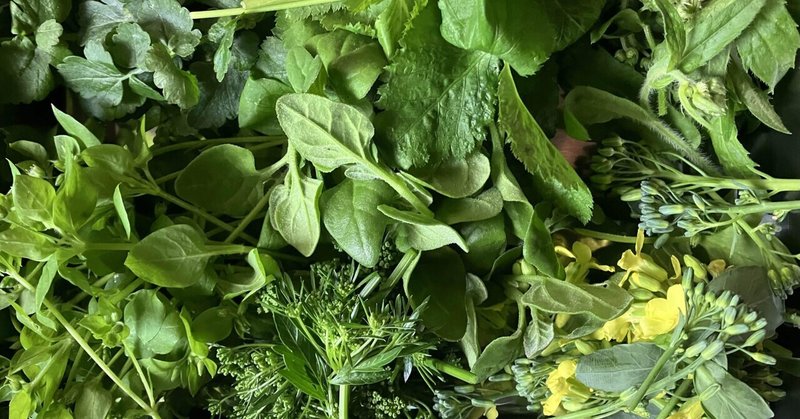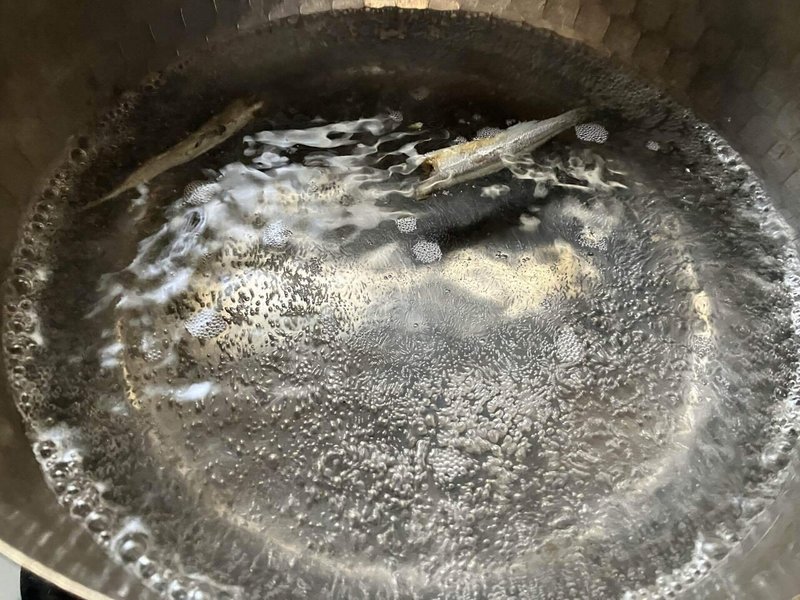
出不精な春の味噌汁 Spring miso soup for feeling lazy
貧乏人の歳時記
A minimalist's seasonal calendar
ストーリー
Recipe trivia
野菜というにはあまりにも野趣に富んでいるけど、味噌汁に使う野菜はアパートの中庭にあるプランターから草むしりついでに調達するのが日課だ。どんな季節でもこの3メートル範囲の収穫で困らない。しかも春は芽吹の季節なので豊作だ。
プランターのイタリアンパセリはすっかり巨大化して盛んに花芽を出している。全部の種が飛ぶと雑草化に拍車がかかるので、花芽の大部分は間引くために摘み取ってしまう。
冬の間は地面にへばりついて成長を止めていたセリとミツバが盛んに葉を拡げだしているので、大きいものから収穫する。実は両方とも栽培しているというよりは、だいぶ昔に買った根付きの三つ葉と芹の根っこが勿体無いので、いけておいたものの子孫だ。今では雑草化している。
Although they are too wild to be called vegetables, it is my daily routine to gather the vegetables for miso soup from the planter in the courtyard of my apartment while weeding. I can harvest within this 3-meter range no matter what season it is. Moreover, spring is the season of budding, so the harvest is bumper.
The Italian parsley in the planter has grown huge and is actively producing flower buds. If all the seeds fly away, it will accelerate the growth of weeds, so I pick off most of the flower buds to thin them out.
僕は園芸は門外漢だ。それでも野菜好きなので、ずっと前からプランター園芸は続けている。技術者の悪い癖で、始めた頃は真面目に園芸書やインターネットにあるプロのアドバイスを見てプランター管理をしていて、疲れてしまった。素人にはやることが多すぎるのだ。一番大仕事が作物の切り替え時期の植替えだ。土を入れ替えて養生して連作障害に気をつけてと、プランターが十個も並ぶと家庭菜園の仕事と変わらない。場所もないのに、土を篩にかけたり、リサイクルしたり、日干ししたり、半日仕事なのだ。僕は車に乗らないので、土の搬出搬入調達にも苦労 する。おまけに長期出張も入る。仕事が本当に忙しくなってほとんど住まいで過ごす時間が無くなって、放置することが多くなった。
ところがである。プロのように計画通りには全く行かないのだけど、そんな状態でも、何かは収穫できるのだ。時期がずれてしまった芽キャベツの葉っぱは柔らかくてしっかり普通の野菜だし、多年草なので、2年目は放置していても結球する。種ができる作物は溢れ種で勝手に翌年生えてくる。何故か自家採種(ものは言いよう)の苗は連作障害を起こし難いようだ(ちゃんと検証はしていないので真似しないでね)。そんなことがあって気を良くし、強すぎる雑草の根や伝染病にかかってそうな苗は早めに取り除き、土質改良剤を少し蒔いて、コンパニオンプランツを意識しながら、そのまま夏の野菜の横に冬野菜の種を蒔き、冬野菜の横に夏野菜の種を蒔くようになった。まあ、人に薦められる方法ではないけど、二人分程度の収穫には困らなくなった。そこからは長く続いている。
I'm not an expert in gardening. Still, I like vegetables, so I've been gardening in planters for a long time. It's a bad habit of engineers, but when I started, I seriously looked at gardening books and professional advice on the Internet to manage the planters, and I got tired. There's too much to do for an amateur. The biggest job is replanting when it's time to switch crops. With ten planters lined up, it's no different from working in a home garden, with replacing the soil, caring for the soil, and being careful about crop failure. Even though there's no space, sifting the soil, recycling it, drying it in the sun, and it's a half-day job. Since I don't have a car, it's hard to get the soil in and out. On top of that, I have to go on long business trips. My work got really busy and I hardly had time to spend at home, so I often left it alone.
But. It doesn't go according to plan like a professional, but even in that situation, I can still harvest something. The leaves of Brussels sprouts that have grown out of season are soft and firm like normal vegetables, and since they are perennials, they will form a head in the second year even if left alone. Crops that produce seeds will overgrow and grow naturally the next year. For some reason, self-seeded (however that may sound) seedlings seem to be less susceptible to problems caused by successive crops (don't try this at home as I haven't tested it properly). Encouraged by this, I started removing strong weed roots and seedlings that looked like they had infectious diseases early on, sowed some soil conditioner, and, keeping in mind companion plants, sowed winter vegetable seeds next to the summer vegetables, and summer vegetable seeds next to the winter vegetables. Well, it's not a method I would recommend to others, but I no longer have trouble harvesting enough for two people. I've been doing it for a long time since then.
そういうわけで、放任栽培なのでプランターの作物の周りは雑草で覆われている。だけど、流石に主人を侵食しそうな大きさの雑草は抜き取る。でも、その半数は可食な奴なので、柔らかいところを選んでキッチンに持ち帰る。
今日の収穫はハルジオンとハコベだ。
アブラナ科の連中は花盛りなので、これも適当に間引く。今日は芽キャベツとブロッコリーと水菜の花芽だ。
それと、なぜか数年前から多年草に転じたつるな。最初は冬になると枯れるので、翌年また種を蒔いていたのだけど、ある時から枯れないで越冬するようになった。
味噌汁の具材には十分な収穫だ。だから味噌汁の野菜は買ったことがない。
That's why the crops in the planters are grown unattended, so they are covered with weeds. However, I do pull out the weeds that are big enough to encroach on the planter's owner. However, half of them are edible, so I pick out the soft parts and take them back to the kitchen.
The seri(japanese celery) and mitsuba, which had been stuck to the ground and stopped growing during the winter, are actively spreading their leaves, so I harvest the larger ones first. In fact, rather than cultivating both, they are the descendants of the mitsuba and japanese ncelery roots that I bought a long time ago and arranged because I didn't want to waste them. They have now become weeds.
Since I've been neglecting the cultivation, the area around the crops in the planter is covered with weeds. However, I do pull out the weeds that are large enough to encroach on the owner of the planter. However, half of them are edible, so I pick out the soft parts and bring them into the kitchen. Today's harvest is philadelphia fleabane and chickweed.
The Brassicaceae members are in full flower, so I thin those out as well. Today's harvest is brussels sprouts, broccoli, and mizuna flower buds.
Also, New Zealand spinach, which for some reason has become a perennial plant a few years ago. At first it would die in winter, so I would sow seeds again the following year, but at some point it started to survive the winter without dying.
The harvest is enough to make ingredients for miso soup. That's why I've never bought vegetables for miso soup.
Ingredients:
材料:
煮干
くさむしりついでの収穫物
薄揚げ
味噌
Niboshi(Dried sardines)
Harvested during weeding
Thin fried tofu
Miso
procedure:
手順:
水に煮干を浸けておく。前日からだとよく出汁が出るが、浸けずに使っても良い。
薄揚げはお湯をかけて酸化した油を洗い流し、小さくカットしておく。野菜は硬い茎などを取り除き、よく洗って、一口大に切り分けておく。
水から煮干を煮出して出汁を取る。
沸騰しているところに、野菜と薄揚げを入れて、軽く煮たら、火を弱め、味噌を溶き、すぐ火を止めて提供する。
Soak the niboshi(dried sardines) in water. If you do it the day before, it will give the dish a good broth, but you can use them without soaking.
Pour hot water over the thin fried tofu to wash off the oxidized oil and cut it into small pieces. Remove tough stems from the vegetables, wash them well and cut them into bite-sized pieces.
Boil the niboshi in water to make the broth.
Add the vegetables and thin fried tofu to the boil and bring to a light simmer, then reduce the heat, dissolve the miso in it, turn off the heat immediately and serve.






Tips and tricks:
コツと応用のヒント:
煮干は頭と内臓をとった方が上品な味になる。ただ、味噌の種類によっては、頭付きの癖のある出汁の方がバランスが良かったりする。高級割烹のシェフに出汁の取り方を聞くと、上品な出汁を教えてくれるが、味噌汁にそういうタイプの出汁を使うと味噌の味に負けてしまう。特に割烹で使うような鰹と昆布の上品な出汁は味噌汁には向かない。僕はおでんやすまし汁などに使う上品な煮干出汁は前の日から頭を取って水出しして、さっと煮たら煮干しは取り出してしまう。そして、味噌汁には一度出汁を取った再利用の煮干と取り除いた頭を使って長めに煮出し、汁ごと煮干も食べてしまう。その辺りは好みで。
ここでは、味噌は華やかで香りの良い麦味噌を使っている。麦味噌は麦麹を使っていてフローラルな香りが特長なので、葉物や豆腐など軽めの具材の味噌汁に合う。白っぽい信州味噌も同様の使い方ができる。もちろん濃い色の田舎味噌が好きな人はそちらを使っても良い。これらのタイプの味噌は香りが命なので、食べる直前に味噌を溶き、煮ない方が良い。香りが飛んでしまう。
別の機会にまた紹介するけど、米を主に使う白味噌や豆を主に使う八丁味噌は、使い方がだいぶ違う。どちらかと言うと煮込んだ方が特長を活かせる。
野菜というか雑草というかは、可食なら何を使っても良い。煮干と味噌の豊かな旨みが癖のある素材でも受け止めてくれる。逆に、単一の素材の繊細な味を味わいたい場合は、すまし汁仕立てにした方が良い。
Niboshi will taste more refined if you remove the head and innards. However, depending on the type of miso, a strong broth with the head still attached may have a better balance. If you ask a chef at a high-end japanese restaurant how to make broth, they will tell you how to make a refined broth, but if you use that type of broth in miso soup, it will be overpowered by the taste of the miso. In particular, the refined broth made with bonito and konbu kelp used in japanese restaurants is not suitable for miso soup. When I make a refined broth from niboshi for oden or clear soup, I remove the heads the day before, infuse it in water, boil it briefly, and then remove the niboshi. Then, for miso soup, I use niboshi with the heads still on, or I use recycled niboshi that I have already used to make broth and the heads removed, boil it for a longer time, and eat the broth with the niboshi still on. It's up to your preference.
Here, we use barley miso, which is gorgeous and fragrant. Barley miso uses barley koji and has a floral aroma, so it goes well with miso soup with light ingredients such as leafy vegetables and tofu. The whitish Shinshu miso can be used in the same way. Of course, if you like darker country miso, you can use that. The aroma is the key to these types of miso, so it's best to dissolve the miso just before eating and not boil it. Otherwise, the aroma will disappear.
I'll introduce these on another occasion, but the way to use white miso, which is mainly made from rice, and Hatcho miso, which is mainly made from beans, is quite different. If anything, you can make the most of their characteristics by stewing them.
You can use any edible vegetables, or weeds for that matter. The rich flavor of the dried sardines and miso will take care of even the more pungent ingredients. On the other hand, if you want to enjoy the delicate flavor of a single ingredient, it's better to make it a clear soup.
Guide to where to get ingredients and equipment 材料と機材の入手先ガイド
この記事が気に入ったらサポートをしてみませんか?
